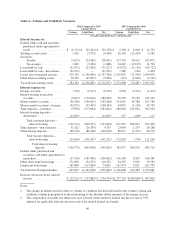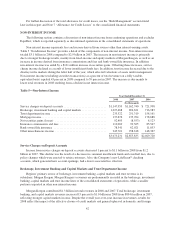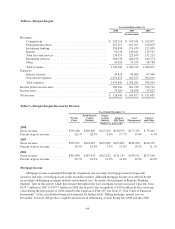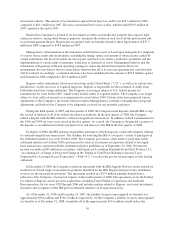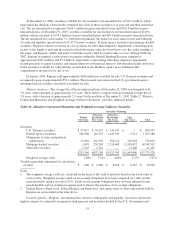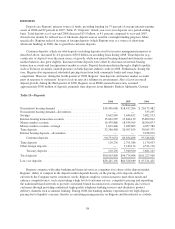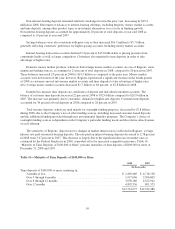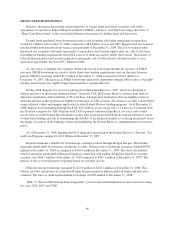Regions Bank 2008 Annual Report Download - page 60
Download and view the complete annual report
Please find page 60 of the 2008 Regions Bank annual report below. You can navigate through the pages in the report by either clicking on the pages listed below, or by using the keyword search tool below to find specific information within the annual report.investment vehicles. The amount of tax benefit recognized from these tax credits was $56.3 million in 2008
compared to $81.3 million in 2007. The non-conventional fuel source credits, which totaled $39.6 million in
2007, expired at the end of 2007.
Regions has segregated a portion of its investment securities and intellectual property into separate legal
entities in order to, among other business purposes, maximize the return on such assets by the professional and
focused management thereof. Regions has recognized state tax benefits related to these legal entities of $37.5
million in 2008 compared to $45.8 million in 2007.
Management’s determination of the realization of deferred tax assets is based upon management’s judgment
of various future events and uncertainties, including the timing, nature and amount of future income earned by
certain subsidiaries, the level of taxable income in prior carryback years where carryback is permitted, and the
implementation of various plans to maximize realization of deferred tax assets. Management believes that the
subsidiaries will generate sufficient operating earnings to realize the deferred tax benefits. However,
management does not believe that it is more-likely-than-not that all of its state net operating loss carryforwards
will be realized. Accordingly, a valuation allowance has been established in the amount of $22.5 million against
such benefits in 2008 compared to $19.2 million in 2007.
Regions and its subsidiaries file income tax returns in the United States (“U.S.”), as well as in various state
jurisdictions. As the successor of acquired taxpayers, Regions is responsible for the resolution of audits from
both federal and state taxing authorities. The Company is no longer subject to U.S. federal income tax
examinations for years before 2007, which would include audits of acquired entities. The Company is no longer
subject to state and local income tax examinations for years before 2000. Certain states have proposed various
adjustments to the Company’s previously filed tax returns. Management is currently evaluating those proposed
adjustments and believes the Company to be adequately reserved for any potential exposures.
During the third quarter of 2007 and first quarter of 2008, the Company made deposits with the IRS to stop
the accrual of interest on all of its federal uncertain tax positions. In the first quarter of 2008, the Company
settled a dispute with the IRS related to certain leveraged lease transactions. In addition, federal examinations for
the 1998 and 1999 tax years were closed in the first quarter. As a result, the Company re-designated a portion of
the deposits as an additional statutory payment of tax and interest to the IRS in the first quarter of 2008.
In August of 2008, the IRS announced guidelines pursuant to which taxpayers could settle disputes relating
to certain leveraged lease transactions. The deadline for notifying the IRS of a taxpayer’s intent to participate in
the settlement initiative was early October 2008. The Company gave notice of the intent to participate in the
settlement initiative in October 2008 and increased its reserves for interest on exposures related to leveraged
lease transactions consistent with the settlement initiative guidelines as of September 30, 2008. Net interest
income was reduced $43 million in accordance with Financial Accounting Standards Board Staff Position 13-2,
“Accounting for a Change or Projected Change in the Timing of Cash Flows Relating to Income Taxes
Generated by a Leveraged Lease Transaction” (“FAS 13-2”), to reflect the pre-tax income impact of the leasing
settlement.
In December of 2008, the Company reached an agreement with the IRS Appeals Division on the federal tax
treatment of a broad range of uncertain tax positions identified by the IRS. Regions had previously established
reserves for the uncertain tax positions. The agreement resulted in a $275 million earnings benefit from a
reduction of the Company’s income tax expense in the fourth quarter of 2008. The agreement covers the Federal
tax returns of Regions and its previous acquisitions, including Union Planters Corporation and AmSouth
Bancorporation, for tax years 1999 through 2006 and includes matters related to Regions’ real estate investment
structures and acceptance of the IRS global settlement initiative on leasing transactions.
As of December 31, 2008 and December 31, 2007, the liability for gross unrecognized tax benefits was
approximately $54.6 million and $746.3 million, respectively. Of the Company’s liability for gross unrecognized
tax benefits as of December 31, 2008, essentially all of the approximately $54.6 million would reduce the
50


